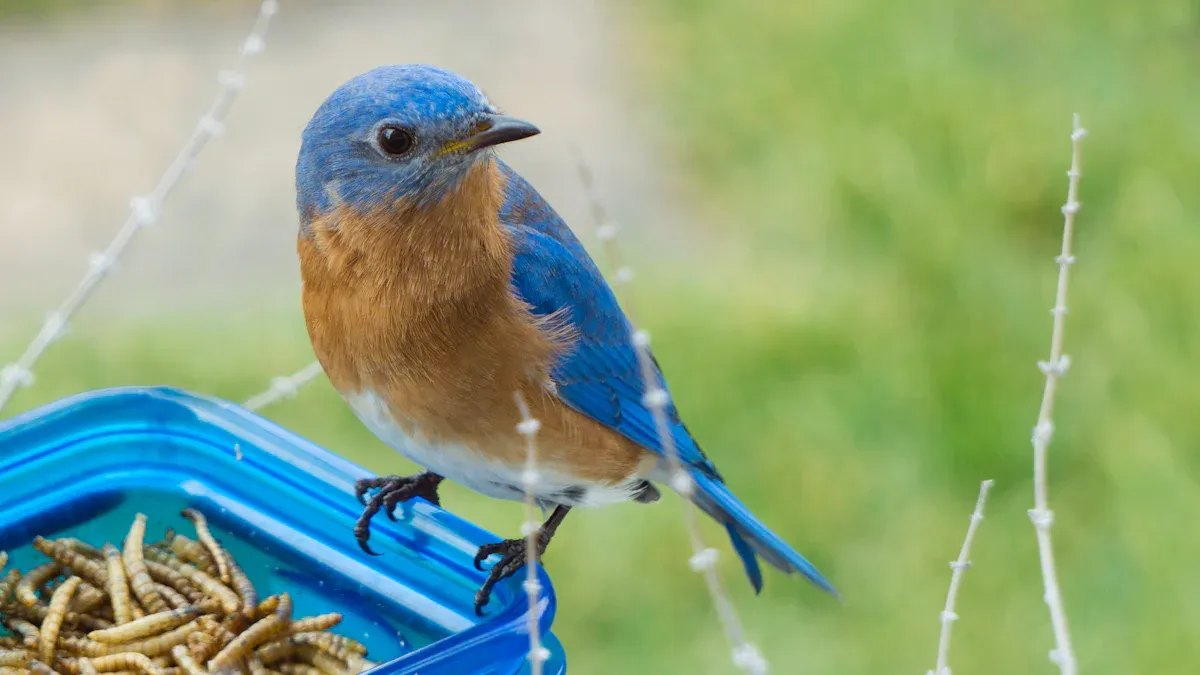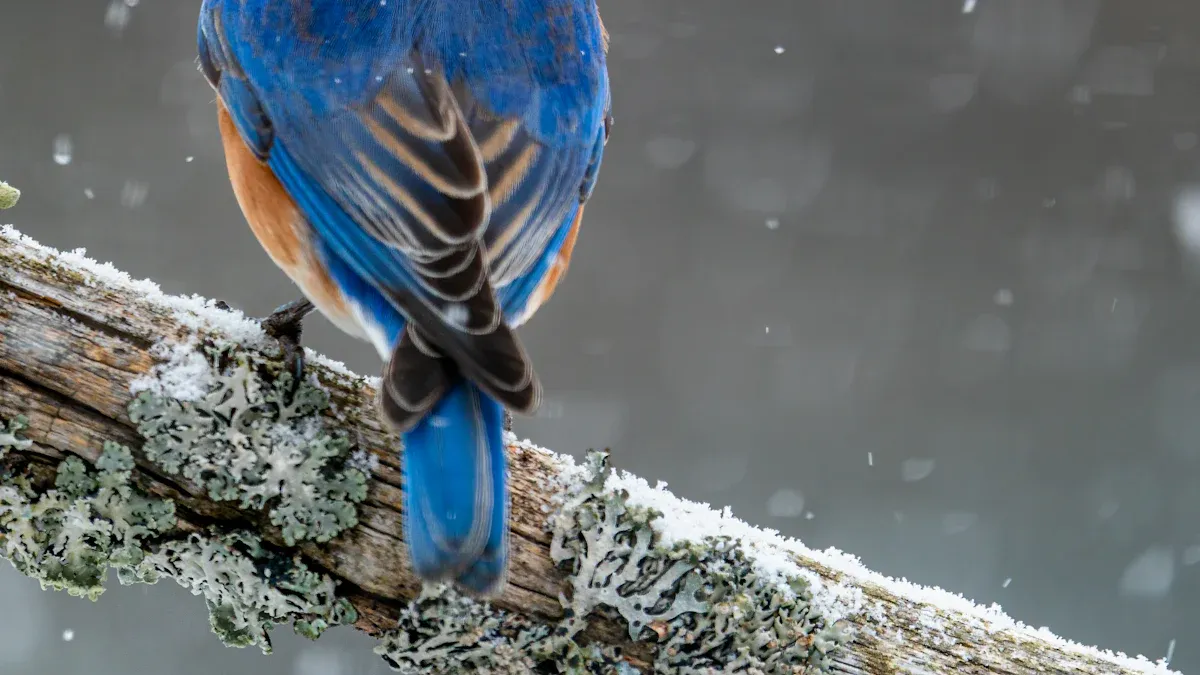
Imagine a bluebird hopping around your yard, its vibrant feathers shimmering in the sunlight. What if you could make its day with a simple snack? Dried mealworms might just be the treat they’re looking for! Packed with protein (52.8%) and healthy fats (24.7%), these little morsels provide the energy bluebirds need to thrive. Plus, they’re easy to store and serve, making them a convenient option for you.
But wait—are dried mealworms really the best choice? Some worry about their lack of moisture or whether bluebirds will even like them. Don’t fret! Bluebirds are naturally drawn to insects, and mealworm feed can mimic their favorite wild treats. With a little preparation, you can turn your backyard into a bluebird paradise.
Key Takeaways
- Dried mealworms are healthy snacks for bluebirds. They give protein and fats to boost their energy.
- Soak dried mealworms in water before feeding. This makes them moist and better for young bluebirds.
- Use easy feeders and give mealworms often. This helps bring bluebirds to your yard and makes them feel welcome.
Nutritional Benefits of Mealworm Feed

Key nutrients in dried mealworms
Dried mealworms are tiny powerhouses of nutrition. They boast an impressive 52.8% crude protein and 24.7% crude fat, making them an excellent energy source for bluebirds. But that’s not all! These little snacks also contain essential minerals like calcium (0.05%) and phosphorus (1.03%), which are vital for strong bones and healthy eggshells.
| Nutrient | Value |
|---|---|
| Crude Protein | 52.8% |
| Crude Fat | 24.7% |
| Calcium | 0.05% |
| Phosphorus | 1.03% |
| Sodium | 0.097% |
| Zinc (ppm) | 144 |
Interestingly, the nutritional value of mealworms can vary based on their diet. Studies show that feeding mealworms a calcium-rich diet can significantly boost their calcium content, making them even better for bluebirds.
How dried mealworms support bluebird health
Mealworm feed isn’t just tasty—it’s a lifesaver! High protein levels help nestlings grow strong and healthy. During cold or wet weather, mealworms provide the extra energy young bluebirds need to survive. For adults, these snacks are a game-changer during the breeding season when energy demands skyrocket. Some studies even suggest that nestlings fed mealworms fledge earlier and have higher survival rates.
Tip: Offering mealworms during nesting season can give bluebird families a much-needed boost!
Why bluebirds are attracted to mealworm feed
Bluebirds love mealworms because they mimic their natural diet. Insects are a staple for these birds, and mealworms deliver the protein and fat they crave. While live mealworms are more appealing, dried ones still do the trick, especially when offered consistently. Plus, during harsh seasons, mealworm feed becomes a reliable food source when insects are scarce.

Dried Mealworms vs. Live Mealworms
Advantages of dried mealworms
Dried mealworms are like the fast food of the bird world—quick, easy, and always ready to serve. You don’t need to worry about keeping them alive or refrigerating them. Just grab a handful and toss them into your feeder. They’re lightweight, mess-free, and have a long shelf life, making them perfect for busy bird enthusiasts.
Cost-effectiveness is another big win. A single bag of dried mealworms can last weeks, especially if you mix them with other bird feed. Plus, they’re less likely to attract unwanted pests like ants or rodents. Convenience and savings? That’s a double win for you and your feathered friends!
Tip: Store dried mealworms in an airtight container to keep them fresh and crunchy.
Disadvantages of dried mealworms
While dried mealworms are handy, they do have their downsides. They lack the moisture that live mealworms provide, which can lead to dehydration in bluebirds, especially nestlings. Young birds rely on moisture from their food since they don’t drink water directly. Without it, they risk constipation or worse.
- Dried mealworms can cause digestive issues in nestlings.
- Overfeeding dried mealworms may lead to fatal dehydration.
- Even when soaked, they don’t match the nutritional balance of live mealworms.
For adult bluebirds, dried mealworms are fine in moderation. But for growing chicks, they might not be the best choice.
When live mealworms might be a better option
Sometimes, live mealworms are the way to go. Bluebirds naturally prefer live food because it’s closer to what they eat in the wild. The wriggling movement also grabs their attention, making it easier to attract them to your feeder.
Live mealworms shine during nesting season. They provide the essential moisture that nestlings need to stay hydrated and healthy. If you notice young bluebirds in your yard, consider switching to live mealworms to support their growth. While they require more effort to store and feed, the benefits for your bluebird family are worth it.
Note: If you’re feeding live mealworms, keep them in a cool place to slow their movement and make handling easier.
Feeding Bluebirds with Mealworm Feed

Preparing dried mealworms for feeding
Before serving dried mealworms, a little preparation can make them irresistible to bluebirds. Rehydrating them is a game-changer! Soak the mealworms in hot water for about 15 minutes. This process softens them and adds moisture, making them more appealing. For an extra nutritional boost, mix in a sprinkle of wheat germ or powdered milk. Want to get creative? Add thin slices of apple or potato to the feeder for a natural moisture source. Just be sure to remove any leftovers to avoid mold.
| Preparation Method | Description |
|---|---|
| Rehydrating Dried Mealworms | Soak in hot water for 15 minutes or in vegetable oil to enhance attractiveness to bluebirds. |
| Nutritional Additives | Mix in wheat germ, powdered milk, or ground dog food to increase nutritional value. |
| Moisture Sources | Include thin slices of potato or apple to provide moisture, but avoid mold. |
Tip: If you’re in a hurry, a quick soak in boiling water for 3-4 minutes works too!
Choosing the right feeder for bluebirds
Bluebirds aren’t picky about where they eat, but the right feeder can make all the difference. A simple dish on your deck rail or a platform feeder works wonders. These setups let bluebirds spot the mealworms easily. If you’re feeling fancy, try a bluebird-specific feeder with a roof to keep the mealworms dry.
Avoid feeders with deep bowls or narrow openings. Bluebirds prefer open spaces where they can perch comfortably. Place the feeder in a quiet spot, away from predators and heavy foot traffic.
Pro Tip: Position the feeder near shrubs or trees. Bluebirds love having a safe retreat nearby!
Acclimating bluebirds to dried mealworms
Switching bluebirds from live to dried mealworms takes patience. Start by mixing a few dried mealworms with live ones. Gradually increase the ratio of dried to live mealworms over a week or two. Bluebirds will soon recognize dried mealworms as a reliable food source.
If they seem hesitant, try soaking the dried mealworms to mimic the texture of live ones. Consistency is key. Offer mealworm feed at the same time and place daily to build trust.
Seasonal feeding tips
Bluebirds’ feeding habits change with the seasons. During nesting season, live mealworms are a better choice since they provide essential moisture for nestlings. However, dried mealworms can still play a role. Rehydrate them to make them more suitable for young birds.
In winter, bluebirds may lose interest in mealworms when temperatures drop below 40°F. To keep them coming back, place the feeder in a heated area or add a small heat source nearby. This keeps the mealworms from freezing and makes them more appealing.
Winter Hack: Pair mealworm feed with high-energy foods like suet to help bluebirds survive the cold months.
Feeding bluebirds with mealworm feed is a win-win for you and your feathered friends. It’s nutritious, easy to serve, and keeps bluebirds coming back for more. Preparation and moderation are key to success. Use caged feeders to prevent larger birds from stealing the show. Offer small portions—about a dozen mealworms at a time—to build trust and establish a routine. If bluebirds don’t bite right away, don’t leave the mealworms out. Patience pays off! With a little effort, you’ll create a backyard haven that bluebirds will love. 🐦
FAQ
Can bluebirds eat only mealworms?
Nope! Bluebirds need variety. Add fruits like raisins or berries and high-protein suet to their diet. A balanced menu keeps them healthy and happy. 🍎🐦
How many mealworms should I feed daily?
Stick to about 10-15 mealworms per bird. Overfeeding can spoil their appetite for natural food. Moderation is key to keeping them coming back.
Tip: Start small and adjust based on how many bluebirds visit your feeder.
Do dried mealworms attract other birds?
Yes, they do! Robins, wrens, and chickadees love mealworms too. Use a bluebird-specific feeder to give your bluebirds a fair chance at the feast. 🐦✨


